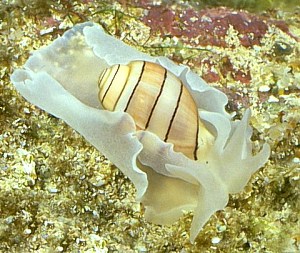
Hydatina amplustre
(Linnaeus, 1758)
Order: CEPHALASPIDEA
Superfamily: ACTEONOIDEA
Family: Hydatinidae
DISTRIBUTION
Tropical Indo-West Pacific.
PHOTO
Rottnest Is, Western Australia. Animal approx 2cm long. PHOTO: Clay Bryce.
Smaller and with a more heavily calcified shell than the other species of Hydatina, this species with its characteristic pink bands outlined in black, is found throughout the tropical Indo-West Pacific. It is reported to feed on cirratulinid polychaete worms (Rudman, 1972).
Reference:
• Rudman, W.B. (1972) The anatomy of the opisthobranch genus Hydatina and the functioning of the mantle cavity and the alimentary canal. Zoological Journal of the Linnean Society 51(2): 121-139.
Rudman, W.B., 1999 (July 12) Hydatina amplustre (Linnaeus, 1758). [In] Sea Slug Forum. Australian Museum, Sydney. Available from http://www.seaslugforum.net/find/hydaampl
Related messages
Mating Hydatina amplustre from Reunion Island
January 9, 2009
From: Hugues Flodrops
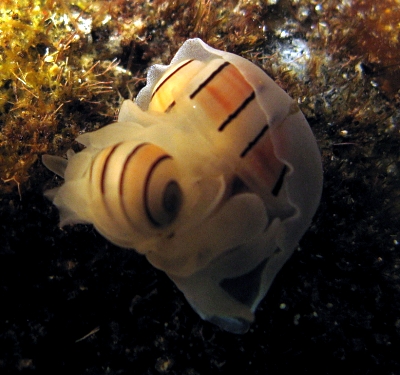
Concerning message #18346:
Dear Bill,
A picture of a pair of Hydatina amplustre mating.
Locality: Etang-Salé "Permanent Pool", 1,5 metre, Reunion Island, Indian Ocean, 16 December 2008, Night. Length: 10-20 mm. Photographer: Hugues Flodrops.
Merry Christmas.
Hugues.
hugues.flodrops@wanadoo.fr
Flodrops, H., 2009 (Jan 9) Mating Hydatina amplustre from Reunion Island. [Message in] Sea Slug Forum. Australian Museum, Sydney. Available from http://www.seaslugforum.net/find/22123Dear Hugues,
Thanks for both the Christmas Greetings and the record of H. amplustre. It's a puzzle why some species, like this one, are rarely found, while closely related species, such as H. physis, can be so abundant.
Best wishes,
Bill Rudman
Hydatina amplustre from Lau Islands, Fiji
October 9, 2007
From: Peter Middelfart
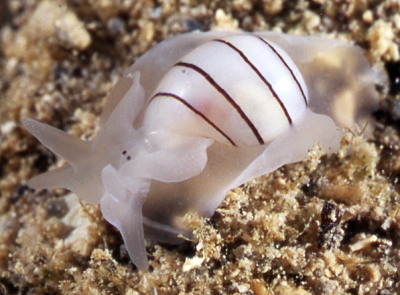
Hi Bill
We did not see you after our Lau expedition and before returning to Canada, so here is an open question to your forum. We found this very small cephalaspid (probably less than 2 cm) on Toubou reef flat in Lakeba, Lau Islands. We can't place it using the pictures on the forum, so perhaps you have a clue.
Locality: Toubou reef flat, 0-1 m, Lakeba, Lau Islands, Fiji, Pacific, Aug. 18, 2007, sandy inner reef flat. Length: 2 cm
All the best,
Peter and Lisa
petermiddelfart@hotmail.com
Middelfart, P., 2007 (Oct 9) Hydatina amplustre from Lau Islands, Fiji. [Message in] Sea Slug Forum. Australian Museum, Sydney. Available from http://www.seaslugforum.net/find/20901Dear Peter,
This is Hydatina amplustre. Usually there a two pink bands across the shell, but they can be quite faint, and in this case absent.
Best wishes,
Bill Rudman
Hydatina amplustre from Reunion Island
November 14, 2006
From: Hugues Flodrops
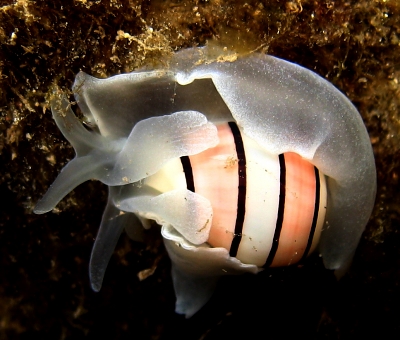
Dear Bill,
Here are three photos of Hydatina amplustre, all of the same individual. I saw another one three years ago at the same place. I like this cephalaspid because the shell with pink and white spiral is very beautiful. On the lower left photo, are the two black points the eyes?
Locality: Etang-Salé Lagoon, 80 cm, Reunion Island, Indian Ocean, 13 November 2006. Length: 20 mm. Photographer: Hugues Flodrops.
It seems that the animal can't be fully retracted into the shell, why?
Thanks for your comments.
Best regards.
Hugues.
hugues.flodrops@wanadoo.fr
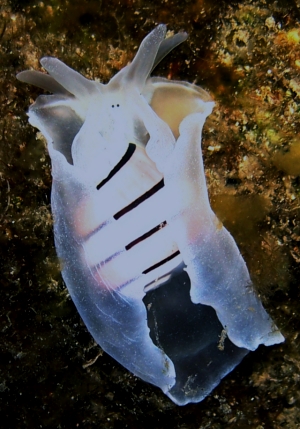
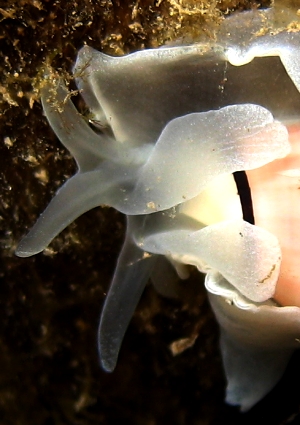
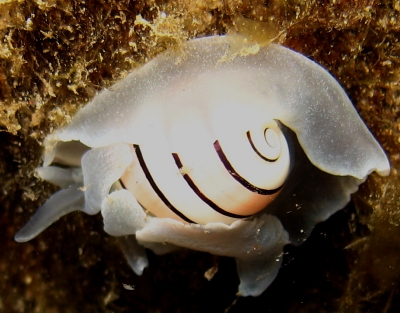
Dear Hugues,
Thanks for these photos. I guess that apart from a few acteonids, such as Acteon eloiseae, this is probably the only species of sea slug with a shell that is more beautiful and colourful than the animal.
Your photos are particularly valuable because they show how the front of the head shield is developed into a pair of tentacles on each side. Hydatina physis has a similar arrangement but it is more difficult to see because the 'tentacles' are much larger and lobe-like. Yes the two black spots are the eyes.
All species of Hydatina can retract back into their shell but they seldom do. The rely on distasteful acid glands in their skin and burrowing in the sand to protect them. There is also a mechanical reason for their poor ability to retract back into the shell. Most snails have a solid shell and a central heavily calcified central 'pole' we call the columella around which the shell, and animal, spirals. There is a huge columella muscle which attaches the animal to the shell and can quickly pull the animal back inside when necessary. In Hydatina, in which the shell is becoming reduced in importance, the columella has become very reduced, as has the associated columellar muscle.
Best wishes,
Bill Rudman
Hydatina amplustre from southern New South Wales
April 22, 2003
From: Debby Lange
Dear Bill,
During a night walk on the sands of Merimbula Lake, (New South Wales, eastern Australia) at low tide we found 2 specimens of Hydatina amplustre. Is it known to be found as far south as Merimbula?
Debby Lange
tekapo@asitis.net.au
Dear Debbie,
I can't think of a record of Hydatina amplustre from as far down the New South Wales coast as Merimbula, but I am never surprised by what will turn up down there. I have even found the very tropical Bornella stellifera even further south at Eden. At various stages of our changing weather cycle, huge warm water eddies from the Southeastern Australian Current break off and drift down the New South Wales coast, carrying with them the larval stages of a lot of tropical marine life. We seem to be in one of those stages at the moment. A month or so ago we found the related tropical species Micromelo undata at Wollongong, south of Sydney.
If you have a photo of your find it would make an interesting record to include on the Forum
Best wishes,
Bill Rudman
Hydatina amplustre from South Africa
July 13, 1999
From: Ernest C.J. Seamark
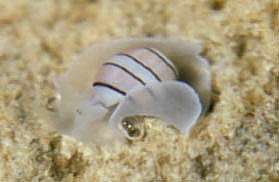
H. amplustre is very uncommon visitor to Treasure Beach intertidal zone. Specimens have been collected - 17 Oct 1997, 27 Mar 1998. They have been found together with H. physis and Micromelo undata.
[Treasure Beach is in Durban, KwaZulu Natal, South Africa.]
Ernest Seamark
kearneyt@biology.und.ac.za
Seamark, E.C.J., 1999 (Jul 13) Hydatina amplustre from South Africa. [Message in] Sea Slug Forum. Australian Museum, Sydney. Available from http://www.seaslugforum.net/find/1043Thanks Ernest,
I don't know anywhere where it's reported to be common, Unlike Hydatina physis or Bullina lineata which can sometimes be quite abundant.
Bill Rudman.
